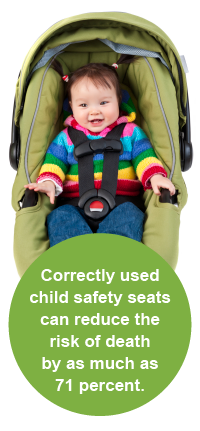CAR SEAT SAFETY TIPS
The best way to keep your child safe in the car is to use the right car seat in the right way. Here are some car seat safety tips to protect your most precious cargo.
Hard Facts about Safety in Cars
Image

- Road injuries are the leading cause of preventable deaths and injuries to children in the United States.
- Correctly used child safety seats can reduce the risk of death by as much as 71 percent.
- More than half of car seats are not used or installed correctly.
Top Tips about Car Seat Safety
- Buying the right car seat. Your baby needs to ride in a rear-facing car seat as long as possible until 2 or more years. When your child has outgrown that seat, you are ready for a forward-facing car seat. Get more details about buying the right car seat for your child.
- Installing your car seat. You’ll need to decide on using either the seat belt or lower anchors to secure your car seat. Both are safe, but don’t use them both at the same time. Once your child is forward facing, it is important to use the tether with the seat belt or lower anchors. Get more details about installing your car seat.
- Getting the right fit. A properly-fitted harness gives the best possible protection for your child. Here are more details about getting the right fit for your child.
- When to change your car seat. Look on the car seat label to make sure your child is still within the weight, height and age limits for that seat. Get details about when to change your car seat.
BOOSTER SEATS
Big kids use belt positioning booster seats (often just called boosters) to stay safe in cars. Even though they might try to convince you otherwise, kids who have outgrown their car seats are just not ready for a seat belt alone. Here are a few tips to make sure your child is safe in a booster seat.
Hard Facts about Safety in Cars
Image

Children seated in a booster seat in the back seat of the car are 45% less likely to be injured in a crash than children using a seat belt alone.
Top Tips for Using Booster Seats
- A booster seat provides a step between a car seat with a harness and a seat belt alone. It enables a safer and more comfortable fit of the adult seat belt.
- Make sure your child has outgrown the weight or height limits allowed in the forward-facing car seat. They must also be mature enough to ride without a harness. What does “mature enough” mean? They need to stay in the booster seat the entire ride with the seat belt properly fitted across the shoulder and below the hips.
- When your child is seated in the booster seat, make sure the lap and shoulder belts fit. The seat belt must lie flat across your child’s chest, on the bony part of the shoulder and low on the hips or upper thighs.
- Do not place the shoulder belt under the child’s arm or behind the child’s back.
- Older kids get weighed and measured less often than babies, so check your child’s growth a few times a year. For most kids, they will be between ages 8 to 12 years old before they are ready for the seat belt alone.
- Be sure you ask about booster use if your child is in a carpool.